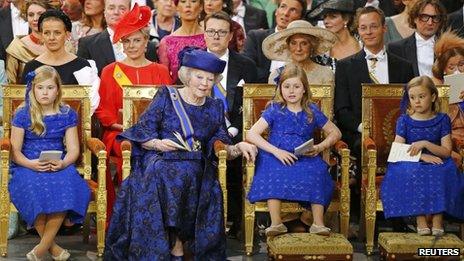The Netherlands' love and respect for Beatrix
- Published

The Dutch people tend to look to the royals as symbols of unity
Decked out in all shades of orange, the crowd in Amsterdam's Dam Square cheered loudly as Queen Beatrix signed the document ending her reign of 33 years.
At that moment, her son Willem-Alexander officially became the Netherlands' first king in nearly 125 years.
Inside the Royal Palace, the mood was more subdued. Never one to wear her emotions on her sleeve, the queen appeared calm if perhaps a little nervous. The first real smile did not come until she went out onto the balcony to introduce the new king to the people.
Let there be no mistake, though: despite her reputation as an intellectual heavyweight and a monarch who liked to wield as much political power as the constitution would allow, Beatrix was and is as much loved by the people as any of her predecessors.
Symbol of unity
One possible explanation for the Dutch royal house's abiding popularity is its close association with freedom from foreign rule: first, in the early 19th Century, that of the French under Napoleon, and more recently, in 1945, that of Nazi Germany.
Argentina-born Maxima has won the hearts of the people of the Netherlands
In addition, Dutch monarchs were never absolute rulers. Before the House of Orange ascended to the throne, the Netherlands had long been a republic. The ruler's powers were held firmly in check by the Dutch constitution: the monarchy was supposed to be there for the people, not the other way around.
As a result, the Dutch people tend to look to the royals as symbols of unity in times of turmoil or political division. Even the populist politician Geert Wilders and his revolt against the Dutch establishment have done nothing to change this. Neither has the fact that in these times of financial crisis, the Dutch monarchy is one of Europe's most expensive to maintain.
However, Queen Beatrix, did not win the people's love and respect without a little tragedy.
The Queen's Consort, Prince Claus, suffered from depression and died in 2002, at the age of 74. On the eve of her abdication, Queen Beatrix said that marrying the plain-spoken German nobleman had been the best decision she ever took. It certainly helped to convince her subjects that she was a woman of flesh and blood.
Tragedy struck again in February 2012, as Beatrix's second son, Prince Johan Friso, suffered a skiing accident and fell into a coma from which he is yet to emerge.
This time, the queen was not afraid to let her emotions show. The shows of sympathy and respect from the Dutch people were overwhelming.
King without a crown
Like his mother, Willem-Alexander may initially have struck the Dutch as difficult to warm to. During his years at Leiden University, he had a reputation for partying hard rather than excelling as a student. But none of that seemed to matter anymore when he married the Argentine Maxima Zorreguieta in 2002.
The popularity of the radiant and charming Maxima soon rivalled that of Queen Beatrix herself. With his wife and their three daughters by his side, Willem-Alexander had no difficulty at all convincing the Dutch that he was ready to succeed his mother and become king.
Willem-Alexander has also proven himself to be a realist. In recent years, the Dutch parliament has moved to limit the political influence of the monarch, which in the past included a role during the formation of a new government.
In a televised interview, the new king said that just waving and ribbon-cutting would suit him fine.
Either way, as celebrations started in the early hours of the morning, nobody seemed too worried about the future of the Netherlands "cycling" monarchy.
Even an actual crown has long been deemed too grand and old-fashioned a symbol for the Dutch ruler.
So as a new era begins, the only crowns on show in Amsterdam are made of orange plastic, and can be found on the heads of the countless revellers who will be partying deep into the night.